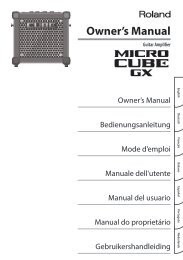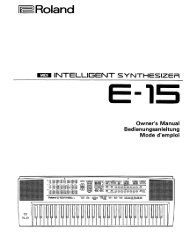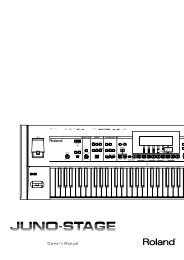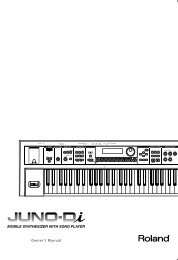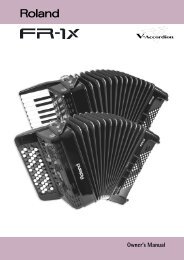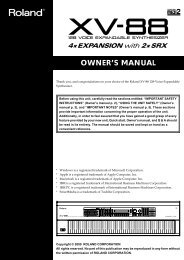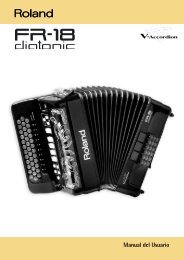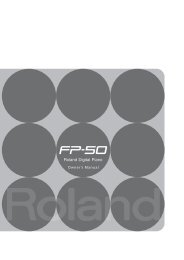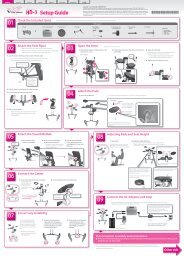Create successful ePaper yourself
Turn your PDF publications into a flip-book with our unique Google optimized e-Paper software.
SOUND mode<br />
Playing back a phrase<br />
(RPS: Realtime Phrase Sequence)<br />
Phrases assigned to each of the eight areas of the D-FIELD<br />
will continue playing as long as you continue pressing that<br />
area.<br />
The phrases assigned to each of the eight areas of the D-<br />
FIELD are collectively managed as an “RPS set.” You are free<br />
to re-assign the contents of an RPS set, and internal memory<br />
can accommodate 30 different sets. You can also switch RPS<br />
sets while a pattern is playing.<br />
Display Explanation Setting<br />
TYPE Select an RPS set. 1–30<br />
➔ Changing the D-FIELD settings (p. 22)<br />
Holding RPS<br />
You can hold the RPS so that the phrase continues playing<br />
even when you take your finger off of the D-FIELD.<br />
• Holding all phrases<br />
1. Press [HOLD] to make it light.<br />
2. Press the D-FIELD to play a phrase.<br />
When you once again press the same area of the D-<br />
FIELD, that phrase will stop.<br />
• Specifying whether each phrase will be held or not<br />
1. While pressing [HOLD], press the D-FIELD to play a<br />
phrase.<br />
[HOLD] will blink, and that phrase will continue playing<br />
until the same area of the D-FIELD is pressed once again.<br />
2. The phrases being held will continue playing until<br />
you hold down [HOLD] and press the D-FIELD as you<br />
did in step 1.<br />
The phrases will be heard together.<br />
3. A phrase that you do not want to hold can be played<br />
by pressing only the D-FIELD.<br />
When you release your finger, that phrase will stop<br />
playing.<br />
* As an alternative to holding down [HOLD] and pressing the<br />
D-FIELD in steps 1 and 2, you can obtain the same result by<br />
holding down the D-FIELD to play the phrase and pressing<br />
[HOLD].<br />
By pressing [HOLD] to make it go dark, you can stop all<br />
phrases.<br />
Chapter 3. About the D-FIELD<br />
Assigning phrases to the D-FIELD<br />
You may find it convenient to assign your favorite or<br />
frequently used phrases as one RPS set.<br />
1. Select the pattern that contains the phrase you want<br />
to assign.<br />
2. Press [PART MUTE], and use the mute buttons to<br />
mute all but the part that you wish to assign to RPS.<br />
3. Hold down [RPS] and turn [VALUE] to select the RPS<br />
set to which you will assign the phrase.<br />
4. While holding down [RPS], press the D-FIELD area<br />
number to which you will assign the pattern.<br />
<br />
* It is not possible for multi-part phrases to be assigned to each<br />
of the eight D-FIELD areas. You must mute all parts other<br />
than the part that contains the phrase you wish to assign. If<br />
you attempt to assign a phrase in which two or more parts are<br />
un-muted, the display will indicate “noASGn”.<br />
* If you have assigned a phrase from a user pattern to RPS, and<br />
modify the performance data of the pattern that contains that<br />
phrase after it has been assigned, be aware that the phrase<br />
played by RPS will be affected by these modifications. For<br />
example if you delete the performance data of a pattern that<br />
contains an assigned phrase, no sound will be heard when you<br />
use RPS to play that phrase.<br />
* If you assign a phrase from a part that uses MFX, the MFX<br />
settings during RPS playback will be determined by the MFX<br />
settings of the currently selected pattern. This means that the<br />
RPS playback may sound different than the original phrase.<br />
* If you assign a phrase from the rhythm part, the rhythm mute<br />
settings will be ignored during RPS playback.<br />
* Each phrase will be played back by a dedicated RPS part 1–8<br />
that corresponds to the eight areas of the D-FIELD. However,<br />
phrases that were assigned from the rhythm part will be played<br />
back by the rhythm part of the currently selected pattern. This<br />
means that in some cases, the phrase may be sounded by a<br />
different rhythm set than that of the assignment source. If a<br />
different rhythm set is selected when you switch patterns, the<br />
rhythm set played by RPS will also change.<br />
23<br />
Chapter 3



